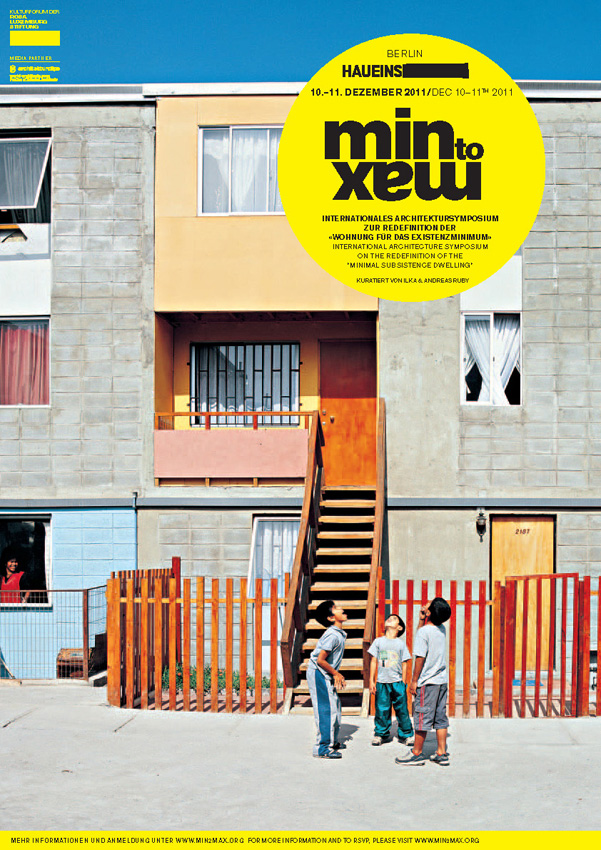
min to max
INTERNATIONAL ARCHITECTURE SYMPOSIUM
ON THE REDEFINITION OF THE «MINIMAL SUBSISTENCE DWELLING»
---
2 day symposium curated by Ilka & Andreas Ruby
participants Saturday Dec 10th:
Matthias Einhoff, ZKU Berlin; Marco Clausen, Prinzessinnengarten; Tim Edler, realities:united; Daniela Brahm & Les Schliesser, ExRotaprint; Christian Schöningh, Die Zusammenarbeiter; Oliver Clemens, Clemens Krug Architekten; Sascha Zander, Zanderroth Architekten; Christian Posthofen, Akademie c/o
Respondent: Andrej Holm, Humboldt-Universität Berlin
Moderated by Ilka & Andreas Ruby, textbild/RUBY PRESS, Berlin
participants Sunday Dec 11th:
Pier Vittorio Aureli, Architectural Association, London; Anne-Julchen Bernhardt and Jörg Leeser, BeL Associates, Cologne; Arno Brandlhuber, Brandlhuber+, Berlin; Alfredo Brillembourg, Urban Think Tank, Caracas; Thomas Flierl, Berlin; Fernando García-Huidobro, ELEMENTAL, Santiago de Chile; Rainer Hehl, ETH Zürich; Diébédo Francis Kéré, Kéré Architecture, Berlin; Fee Kyriakopoulous and Caroline Högsbro, famikja, Berlin; Hubert Riess, Riess Architekten, Graz; Jakob van Rijs, MVRDV, Rotterdam; Christopher Roth, Berlin; Vera Tollmann, Christian von Borries, Berlin; Ting Ting Zhang, William Tan, London
Moderated by Carson Chan, program, Berlin; Michael Kimmelman, architecture critic of the New York Times; Joseph Grima, Chief Editor of DOMUS, Milan
HAU1, Stresemannstr. 29, 10963 Berlin
10 Dec 2011, 19:00 - 21:00
11 Dec 2011, 13:00 - 21:00
An event of →KULTURFORUM RLS
Visit the →min to max website for more information and to register for the event
---
As cost of living increases in Berlin, and in other cities around the world, demand for affordable housing becomes even more pressing. For two days, the international architecture symposium Min to Max will bring together key advocates for housing at HAUEINS, Berlin, to discuss how architects can contribute to a culturally and demographically diverse spatial and urban typology.
In search of new strategies for housing, Min to Max will revisit a crucial development of early Modernism: the Minimum Subsistence Dwelling (Die Wohnung für das Existenzminimum). Formulated at the 2nd CIAM conference, held in Frankfurt in 1929, this doctrine intended to improve living conditions for the working poor by establishing a minimum standard necessary for dignified living.
The concept was widely applied in social housing projects after the Second World War, but with time, its societal perception has completely changed. Today, eighty years later, the Minimum Subsistence Dwelling sanctions the very social inequality that its founders sought to overcome. On an urban scale, this split becomes tangible in the furthering of social segregation in cities.
In response, architects from all over the world are turning their attention once again to the notion of the Minimum Subsistence Dwelling, developing housing typologies that are inexpensive, but spatially attractive, and that can be built all over the city. But unlike the early Modernists, architects today no longer limit the question of housing to the individual dwelling; instead, housing is conceived as the ultimate opportunity for social participation in the spatial fabric of the city